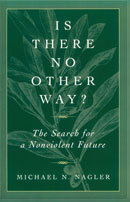Michael Nagler has for years been involved in studying, teaching, practicing, and popularizing nonviolence. In Is There No Other Way? The Search for a Nonviolent Future he describes nonviolence as a very promising but misunderstood discipline that’s still getting off the ground but may one day utterly transform the world.
In Nagler’s view, nonviolence is not just the absence of violence, or a tactical decision to refrain from violence. One doesn’t engage in nonviolence incidentally, but the way a Christian practices Christianity or a reformed alcoholic practices sobriety.
Nagler’s nonviolence is like the ahimsa and satyagraha of Gandhi — designed to transform society, reform and reconcile with enemies, and so forth. It is not the mere “nonviolent struggle” of the Gene Sharp school of thought, not just a set of tools for wielding power in political conflicts (where the goal is not to reform and reconcile with enemies but to thwart them).
Nagler wants us to become practitioners of his variety of nonviolence, not so that we can use this as a tool in our particular battles, but because he wants to transform the world into a nonviolent one. He’s going for the big prize: “it’s tons more effective not only to be working at the root of the problem instead of the leaves, but to be working there steadily instead of being caught by surprise every time there’s a violent incident.”
Humanity is slowly beginning to learn that nonviolence is a creative force that contains within itself the principle of creative order. It alone seems to be a way to deal with conflict that contains the energy of peace in its very process. Nonviolence (and as far as I can see, only nonviolence) does this by elevating rather than depressing the human image. It alone leads to long-term, deep changes in the social system which will eventually result in the desired goals of loving community within the given society and stable peace with others — in a word, loving community all round. …[And] what may be the most important characteristic: nonviolence provides people with a high, inspiring goal — a task that can be implemented in endless ways to fit each individual’s capacities, be it as small as turning off your television set or as large as de-institutionalizing war.
Is There No Other Way? includes many heartwarming anecdotes of when people turned to nonviolent techniques in violent times and met with success. He stresses that while violent solutions to problems seem to “work,” they often don’t work — in other words, they may thwart an opponent or solve a problem in the short term, but they tend to plant seeds for more problems in the future. On the other hand, nonviolent solutions often don’t seem to “work” but in the long run they work by empowering the community of practitioners, by eroding the intransigence of the opponent, and by fixing other problems along the way instead of creating new ones.
Aside from the anecdotes, this is mostly backed up by the poignant, heartfelt assertion that nonviolence is a panacea — not just for resisting injustice, but for crime and drug abuse prevention, for ruling a country, for giving people purpose in their lives, and so forth.
As a reader, you’re required to do a lot of imagining: “Just imagine what could be done…” “Imagine what the picture would be like…” “Imagine a well-trained peace team defusing a war…”
If you’re a pacifist, you’ll likely respond to this with “right on!” If you’re skeptical of pacifism, you’ll probably not find too much here that will challenge your skepticism. Some of the anecdotes of nonviolence working in difficult situations are potentially persuasive, but these can be found described in greater depth and more convincing detail in other works on nonviolent conflict.

